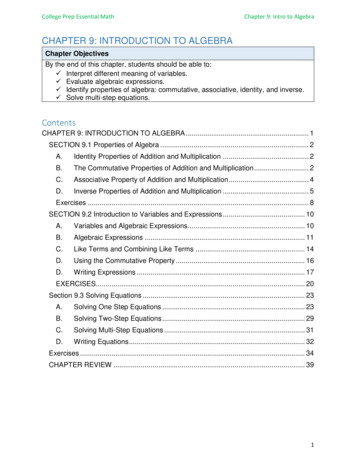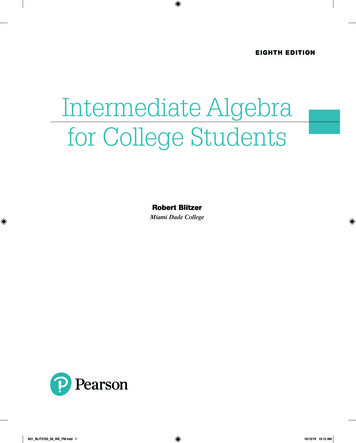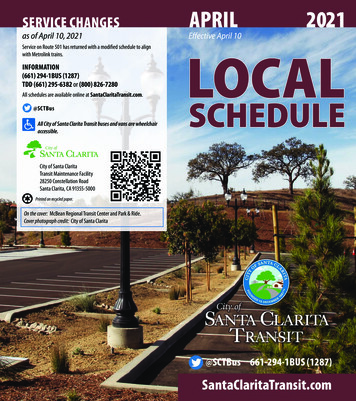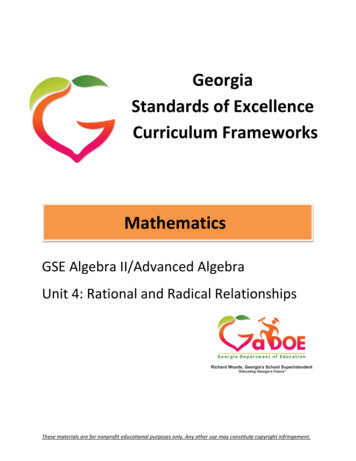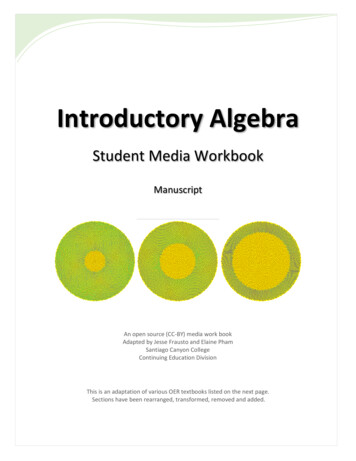
Transcription
Introductory AlgebraStudent Media WorkbookManuscriptAn open source (CC-BY) media work bookAdapted by Jesse Frausto and Elaine PhamSantiago Canyon CollegeContinuing Education DivisionThis is an adaptation of various OER textbooks listed on the next page.Sections have been rearranged, transformed, removed and added.
ACKNOWLEDGEMENTThis workbook is made possible because of the exceptional work done by the following people listed below. Weare deeply grateful.Introductory AlgebraCK-12 flexbookAvailable for free download at:https://sccmath.files.wordpress.com/2012/12/scc introductory algebra book spring 2013.pdfIntroductory Algebra Student Workbook 6th editionScottsdale Community College Development TeamAvailable for free download at: thmetic for College Readiness Student Workbook 1st editionScottsdale Community College Development TeamAvailable for free download at:https://sccmath.files.wordpress.com/2016/07/scc mat 08x 16 17.pdfUnderstanding Algebra(with author’s permission)James Brennan, Boise State UniversityAvailable for free download at inning AlgebraDarlene DiazSantiago Canyon CollegeAvailable for free download at gebra/ebook/product23120734.htmlBeginning and Intermediate AlgebraTyler WallaceAvailable for free download athttp://www.wallace.ccfaculty.org/book/Beginning and Intermediate Algebra.pdfNumerous math video lessons fromJames Sousa at http://www.mathispower4u.com/Tyler Wallace at http://www.wallace.ccfaculty.org/videos.htmlSalman Khan at http://khanacademy.comLarry Perez at o/Cover imageFibonacci spiralsPhoto by Aldo Cavini Benedettihttps://flic.kr/p/5NrdwuSpecial thanks to Shannon Carter and Berenice Diaz for their help with typing up the answer key for this book.i
Copyright 2017, some rights reserved CC-BYIntroductory Algebra is licensed under a Creative Commons Attribution 3.0 Unported License.You are free to share: copy, distribute and transmit the work remix: adapt the workUnder the following conditions: Attribution: You must attribute the work in the manner specified by the author or licensor (butnot in any way that suggests that they endorse you or your use of the work).With the understanding that Waiver: If you get permission from the copyright holder, any of the above conditions can bewaived. Public Domain: Where the work or any of its elements is in the public domain under applicablelaw, that status is in no way affected by the license. Other Rights: In no way are any of the following rights affected by the license.– Your fair dealing or fair use rights, or other applicable copyright exceptions and limitations;– The author’s moral rights;– Rights other persons may have either in the work itself or in how the work is used such aspublicity or privacy rights Notice: For any reuse or distribution, you must make clear to others the license term of thiswork. The best way to do this is with a link to the following web is is a human readable summary of the full legal code which can be read at the following URL:http://creativecommons.org/licenses/by/3.0/ii
TABLE OF CONTENTSCHAPTER 1: THE NUMBERS OF ARITHMETIC . 1SECTION 1.1: THE REAL NUMBER SYSTEM. 4SECTION 1.2: FACTORS AND DIVISIBILITY . 7SECTION 1.3: FRACTIONS . 20SECTION 1.4: DECIMALS. 41SECTION 1.5: INTEGERS. 52SECTION 1.6: ORDER OF OPERATIONS . 74CHAPTER 2: INTRODUCTION TO VARIABLES AND PROPERTIES OF ALGEBRA . 87SECTION 2.1 INTRODUCTION TO VARIABLES . 88SECTION 2.2 PROPERTIES OF ALGEBRA . 101CHAPTER 3: LINEAR EQUATIONS AND INEQUALITIES . 107SECTION 3.1: LINEAR EQUATIONS . 108SECTION 3.2: LINEAR INEQUALITIES . 116SECTION 3.3: LITERAL EQUATIONS . 122CHAPTER 4: LINEAR EQUATION APPLICATIONS . 125SECTION 4.1: INTEGER PROBLEMS. 127SECTION 4.2: MARK-UP AND DISCOUNT PROBLEMS. 130SECTION 4.3: GEOMETRY PROBLEMS . 134SECTION 4.4: VALUE AND INTEREST PROBLEMS . 137SECTION 4.5: UNIFORM MOTION PROBLEMS . 142SECTION 4.6 MIXTURE PROBLEMS. 148CHAPTER 5: GRAPHING LINEAR EQUATIONS . 151SECTION 5.1 GRAPHING AND SLOPE. 152SECTION 5.2 EQUATIONS OF LINES . 160SECTION 5.3 PARALLEL AND PERPENDICULAR LINES. 167CHAPTER 6: SYSTEMS OF TWO LINEAR EQUATIONS WITH TWO VARIABLES . 171SECTION 6.1: SYSTEM OF EQUATIONS: GRAPHING . 172SECTION 6.2: SYSTEMS OF EQUATIONS: THE SUBSTITUTION METHOD . 176SECTION 6.3: SYSTEM OF EQUATIONS: THE ADDITION METHOD . 182SECTION 6.4: APPLICATIONS WITH SYSTEMS OF EQUATIONS . 190iii
CHAPTER 7: INTRODUCTION TO FUNCTIONS . 197SECTION 7.1: RELATIONS AND FUNCTIONS . 198SECTION 7.2: DOMAIN AND RANGE . 206CHAPTER 8: EXPONENTS AND POLYNOMIALS . 211SECTION 8.1: EXPONENTS RULES AND PROPERTIES . 212SECTION 8.2 SCIENTIFIC NOTATION. 217SECTION 8.3: POLYNOMIALS . 223CHAPTER 9: FACTORING EXPRESSIONS AND SOLVING BY FACTORING. 241SECTION 9.1: GREATEST COMMON FACTOR AND GROUPING . 242SECTION 9.2: FACTORING TRINOMIALS OF THE FORM x2 bx c . 249SECTION 9.3: FACTORING TRINOMIALS OF THE FORM ax2 bx c . 253SECTION 9.4: SPECIAL PRODUCTS . 258SECTION 9.5: FACTORING, A GENERAL STRATEGY. 264SECTION 9.6: SOLVE BY FACTORING . 266CHAPTER 10: RATIONAL EXPRESSIONS. 275SECTION 10.1: REDUCE RATIONAL EXPRESSIONS . 276SECTION 10.2: MULTIPLY AND DIVIDE RATIONAL EXPRESSIONS. 281SECTION 10.3 OBTAIN THE LOWEST COMMON DENOMINATOR . 285SECTION 10.4: ADD AND SUBTRACT RATIONAL EXPRESSIONS . 289CHAPTER 11: RATIONAL EQUATIONS AND APPLICATIONS . 295SECTION 11.1: RATIONAL EQUATIONS . 296SECTION 11.2: WORK-RATE PROBLEMS. 303SECTION 11.3: UNIFORM MOTION PROBLEMS . 308SECTION 11.4: REVENUE PROBLEMS . 313CHAPTER 12: RADICALS . 317SECTION 12.1 INTRODUCTION TO RADICALS. 319SECTION 12.2: ADD AND SUBTRACT RADICALS . 329SECTION 12.3: MULTIPLY AND DIVIDE RADICALS . 332SECTION 12.4: RATIONALIZE DENOMINATORS. 341SECTION 12.5: RADICAL EQUATIONS . 346iv
CHAPTER 13: QUADRATIC EQUATIONS AND APPLICATIONS . 355SECTION 13.1: THE SQUARE ROOT PROPERTY. 356SECTION 13.2: COMPLETING THE SQUARE . 361SECTION 13.3: QUADRATIC FORMULA . 366SECTION 13.4: APPLICATIONS WITH QUADRATIC EQUATIONS . 372v
Chapter 1CHAPTER 1: THE NUMBERS OF ARITHMETICChapter ObjectivesBy the end of this chapter, students should be able to: The real number system Factors and divisibility Review operations with fractions Review operations with decimals Review operations with integers Review the order of operationsContentsCHAPTER 1: THE NUMBERS OF ARITHMETIC . 1SECTION 1.1: THE REAL NUMBER SYSTEM . 4A.NATURAL NUMBERS . 4B.WHOLE NUMBERS . 4C.INTEGERS . 4D.RATIONAL NUMBERS . 5E.IRRATIONAL NUMBERS . 5F.REAL NUMBERS . 6SECTION 1.2: FACTORS AND DIVISIBILITY. 7A.DIVISIBILITY . 7B.FACTORS . 8C.GREATEST COMMON FACTOR AND LEAST COMMON MULTIPLE . 9D.PRIME AND COMPOSITE NUMBER . 11E.PRIME FACTORIZATION, GCF, AND LCM . 13EXERCISES . 17SECTION 1.3: FRACTION . 20A.WHAT IS A FRACTION? . 20B.FRACTIONS IN CONTEXTS . 21C.REPRESENTING UNIT FRACTIONS . 22D.EQUIVALENT FRACTIONS . 23E.WRITING FRACTIONS IN SIMPLEST FORM . 25F.IMPROPER FRACTIONS AND MIXED NUMBERS . 27G.OPERATIONS WITH FRACTIONS. 29EXERCISES . 36SECTION 1.4: DECIMALS . 41A.INTRODUCTION TO DECIMALS . 41B.OPERATIONS WITH DECIMALS . 431
Chapter 1C.FRACTION AND DECIMAL CONNECTIONS . 47EXERCISES . 50SECTION 1.5: INTEGERS . 52A.INTEGERS AND THEIR APPLICATIONS . 52B.PLOTTING INTEGERS ON A NUMBER LINE . 53C.ABSOLUTE VALUE AND NUMBER LINES . 54D.OPPOSITES AND NUMBER LINES . 55E.ORDERING INTEGERS USING NUMBER LINES . 56F.REPRESENTING INTEGERS USING THE CHIP MODEL . 57G.THE LANGUAGE AND NOTATION OF INTEGERS . 58H.ADDING INTEGERS . 59I.SUBTRACING INTEGERS . 61J.CONNECTING ADDITION AND SUBTRACTION . 63K.USING ALGORITHMS TO ADD AND SUBTRACT INTEGERS . 64L.MULTIPLYING AND DIVIDE INTEGERS . 65EXERCISES . 67SECTION 1.6: ORDER OF OPERATIONS. 74A.INTRODUCTION TO EXPONENTS . 74B.THE ORDER OF OPERATIONS WITH ADDITION AND SUBTRACTION . 76C.THE ORDER OF OPERATIONS WITH MULTIPLICATION AND DIVISION . 77D.THE ORDER OF OPERATIONS FOR , , , . 78E.THE ORDER OF OPERATIONS WITH PARENTHESES . 79F.PEMDAS AND THE ORDER OF OPERATIONS . 82EXERCISES . 83CHAPTER REVIEW . 852
Chapter 1INTRODUCTION TO ALGEBRAMedia LessonBrief Origins of Algebra (Duration 7:17)View the video clip and answer the questions below.1) Who wrote the 1st book of Algebra?2) What is the English translation of the title of the book?3) Where and where was the book written?4) What civilization were the stone tablets found exploring some of the fundamental ideas of algebra?When?5) Who was Diophantus?6) Who lived in India that also significantly contributed to Algebra?7)CHAPTER 1: THE NUMBERS OF ARITHMETICMedia LessonDifferent number systems (Duration 7:04)View the video and fill in the blanks:1) As we journey through the rich and vibrant history of mathematics, we can see how ideas andcreations grew out of2) Through time, the mathematical explorations of men and women from around the globe havegiven us fascinating lenses that3
Chapter 1SECTION 1.1: THE REAL NUMBER SYSTEMA. NATURAL NUMBERSThe real number system evolved over time by expanding the notion of what we mean by the word“number.” At first, “number” meant something you could count, like how many sheep a farmer owns.These are called the natural numbers, or sometimes the counting numbers.1, 2, 3, 4, 5, . . .The use of three dots at the end of the list is a common mathematical notation to indicate that thelist keeps going forever.B. WHOLE NUMBERSAt some point, the idea of “zero” came to be considered as a number. If the farmer does not have anysheep, then the number of sheep that the farmer owns is zero. We call the set of natural numbersplus the number zero the whole numbers.0, 1, 2, 3, 4, 5, . . .Natural Numbers together with “zero”MEDIA LESSONWhat is Zero? Getting Something from Nothing (Duration 3:52)View the video lesson, take notes and complete the problems below.1)What are the two roles of 0?2)Who defined 0 explicitly?3)0 and what number made up the binary numerical system formed the foundation for moderncomputer programing?MEDIA LESSON (Optional)Discovery of Zero ( Duration 5:29)C. INTEGERSEven more abstract than zero is the idea of negative numbers. If, in addition to not having any sheep,the farmer owes someone 3 sheep, you could say that the number of sheep that the farmer owns isnegative 3. It took longer for the idea of negative numbers to be accepted, but eventually they cameto be seen as something we could call “numbers.” The expanded About Negative Numbersset of numbers that we get by including negative versions of the How can you have less than zero?Well, do you have a checkingcounting numbers is called the integers.Whole numbers plus negatives. . . –4, –3, –2, –1, 0, 1, 2, 3, 4, . . .The number zero is considered to be neither negative norpositive.account? Having less than zeromeans that you have to add some toit just to get it up to zero. And if youtake more out of it, it will be evenfurther less than zero, meaning thatyou will have to add even more justto get it up to zero.4
Chapter 1D. RATIONAL NUMBERSMEDIA LESSONIntroduction to rational and irrational numbers (Duration 5:54)View the video lesson, take notes and complete the problems below.Rational numbers are numbers that can be written in the form ��𝑒𝑛𝑜𝑚𝑖𝑛𝑎𝑡𝑜𝑟, where 𝑎 and 𝑏are integers (but 𝑏 cannot be zero). Rational numbers include what we usually call fractions. Notice that the word “rational” contains the word “ratio,” which should remind you of fractions. Some decimals are also rational numbers because some decimals can be converted to fractions. RESTRICTION: The denominator cannot be zero! (But the numerator can)Examples:3423 0.75Rational (terminates) 0.66666 0. 6̅Rational (terminates)511̅̅̅̅ 0.454545 0.45Rational (terminates)There are numbers that cannot be expressed as a fraction, and these numbers are called irrationalbecause they are not rational.NOTE: The denominator cannot be zero! (But the numerator can). A fraction has the5denominator is undefined. For example, undefined.0 0If the numerator is zero, then the whole fraction is just equal to zero. For example, 05E. IRRATIONAL NUMBERSIrrational numbers are numbers: cannot be expressed as a ratio of integers. as decimals they never repeat or terminate (rational decimals always repeat or terminate)Examples:2.568432165 Irrational (Never repeats or terminates) 2 1.41421356 Irrational (Never repeats or terminates)𝜋 3.14159265 Irrational (Never repeats or terminates)Below is an example of irrational numbers on a number line approximately:To get the exact location of 2 1.414213 . on a number line,we can apply the Pythagorean Theorem to a right triangle withthe length of each leg equal 1 to find the hypotenuse length of 2 like the diagram on the right.We can use the same method, apply the Pythagorean Theorem to other right triangles to find theexact location of 3, 4, 5 etc. on the number line.5
Chapter 1MEDIA LESSONMaking sense of irrational numbers (Duration 4:41) (Skip 1:50 to 3:08)View the video lesson, take notes and complete the problems below.1) Which of these numbers is/are rational: A) 3A. A) onlyB. A) and B) onlyC. All of the aboveD. None of the aboveB) 12.1C) 52) What are irrational numbers?A. Numbers which do not make any sense to the common manB. Real numbers which can be expressed as a ratio of two integers in the form p/q and wherethe denominator is always non-zeroC. Numbers which are exactly opposite to rational numbersD. Real numbers which cannot be expressed as a ratio of integers3) Which of the following statements is true?A. Pi 22/7B. Pi 355/13C. Pi is the ratio of a circle’s circumference to its diameterD. Pi is the ratio of a circle’s diameter to its circumferenceE. Pi is a terminating recurring decimalF. REAL NUMBERS Rational Irrational numbers All points on the number lineWhen we put the irrational numbers together with the rational numbers, we finally have the completeset of real numbers. Any number that represents an amount of something, such as a weight, a volume,or the distance between two points, will always be a real number. The following diagram illustratesthe relationships of the sets that make up the real numbers.6
Chapter 1SECTION 1.2: FACTORS AND DIVISIBILITYA. DIVISIBILITYDivisible: When one number can be divided by another number and the result is an exact wholenumber that is there is no remainder left.Example: 12 is divisible by 3 because 12 3 4 exactly with no remainder.13 is not divisible by 3 because 13 3 4 with remainder 1.Divisibility RulesMedia LessonDivisibility Rules (Duration 9:34)View the video lesson, take notes and complete the problems below.1) A number is divisible by 2 if .Example: 512: Yes431: No2) A number is divisible by 4 if .Example:3) A number is divisible by 8 if .Example:4) A number is divisible by 3 if .Example:5) A number is divisible by 6 if .Example:6) A number is divisible by 9 if .Example:7) A number is divisible by 10 if .Example:8) A number is divisible by 5 if .Example:YOU TRYDetermine if the given number is divisible by 2, 3, 4, 5, 6, 8, 9, 10.a) 8,064Yes/Nob) 270Yes/NoYes/NoYes/NoBy 2By 6By 2By 6By 3By 8By 3By 8By 4By 9By 4By 9By 5By 10By 5By 107
Chapter 1B. FACTORSFactors of a number are the numbers you multiply together to make that number.Example: 2 x 5 10, 2 and 5 are factors.Factor 9Factor x2Product 18Media LessonFactors (Duration 5:47)View the video lesson, take notes and complete the problems below.Here is another definition of factors.Factors are the numbers that divide evenly into a number. This means a factor divides into anothernumber and there is no remainder.Example: The factor of 15 are 1, 3, 5, 15 since 1 15 153 5 15Determine the factors of each number.1) 242) 543) 1204) 23FINDING FACTORS USING PERFECT SQUARESMedia LessonFinding all of the Factor of a Number using Perfect Squares (Duration 13:54)View the video lesson, take notes and complete the problems below.Method: To determine all of the factors of a whole number, we will find all the pairs of whole numberswhose product is the number. We will check all the numbers whose square is less than the number weare trying to factor.8
Chapter 1Table of Perfect Squares22 423 942 1652 2526 3672 4982 6492 81102 100112 121122 144132 169Directions: Find all factors of the given numbers by finding factor pairs. Use the table of perfect squaresto see what the largest number you have to check is. Write your final answer as a list of factors separatedby commas.a) 18Largest number you have to check:List of Factors:b) 90Largest number you have to check:List of Factors:YOU TRYa) 84Largest number you have to check:List of Factors:C. GREATEST COMMON FACTOR AND LEAST COMMON MULTIPLEMedia LessonIntro to Greatest Common Factor and Least Common Multiple (Duration: 9:54)View the video lesson, take notes and complete the problems below.a) You and your friends are sending care packages to military service members overseas. Eachpackage will contain brownies and cookies. You have 20 brownies and 12 cookies. Every packagemade needs to be identical. What is the greatest number of packages you can send that meetsthis requirement?# of Packages# of Brownies# of Packages# of Cookies9
Chapter 1b) Judy and Dan are running around a track. Judy can run one lap in 3 minutes while it takes Dan 4minutes. If they both start at the same time, how many minutes will it take them to meet?MEDIA LESSONFinding the Greatest Common Factor of Two Numbers (Duration 5:12)View the video lesson, take notes and complete the problems below.Common Factors of two numbers are factors that both numbers share.The Greatest Common Factor (GCF) of two numbers is the largest of these common factors.a) Find all factors of 36. Write your final answer as a list of factors separated by commas.List of Factors 36:b) Find all factors of 90. Write your final answer as a list of factors separated by commas.List of Factors of 90:c) List the common factors of 36 and 90:d) Identify the Greatest Common Factor (GCF) of 36 and 90:YOU TRYFinding the GCF of Two Numbersa) Find all factors of 24. Write your final answer as a list of factors separated by commas.List of Factors 24:b) Find all factors of 60. Write your final answer as a list of factors separated by commas.List of Factors of 60:c) List the common factors of 24 and 60:d) Identify the Greatest Common Factor (GCF) of 24 and 60:10
Chapter 1MEDIA LESSONMultiples, Common Multiples, and Least Common Multiple (Duration 3:26)View the video lesson, take notes and complete the problems below.A multiple of a number is a product of the number with any whole number.Common Multiples of two numbers are multiples that both numbers share.The Least Common Multiple (LCM) of two numbers is the least of these common multiples.a)The first six multiples of 8 are:b)The first six multiples of 12 are:c)Some common multi
Brief Origins of Algebra (Duration 7:17) View the video clip and answer the questions below. 1) Who wrote the 1st book of Algebra? _ 2) What is the English translation of the title of the book? _ _ 3) Where and where was the book written? _ 4) What civilization were the stone
